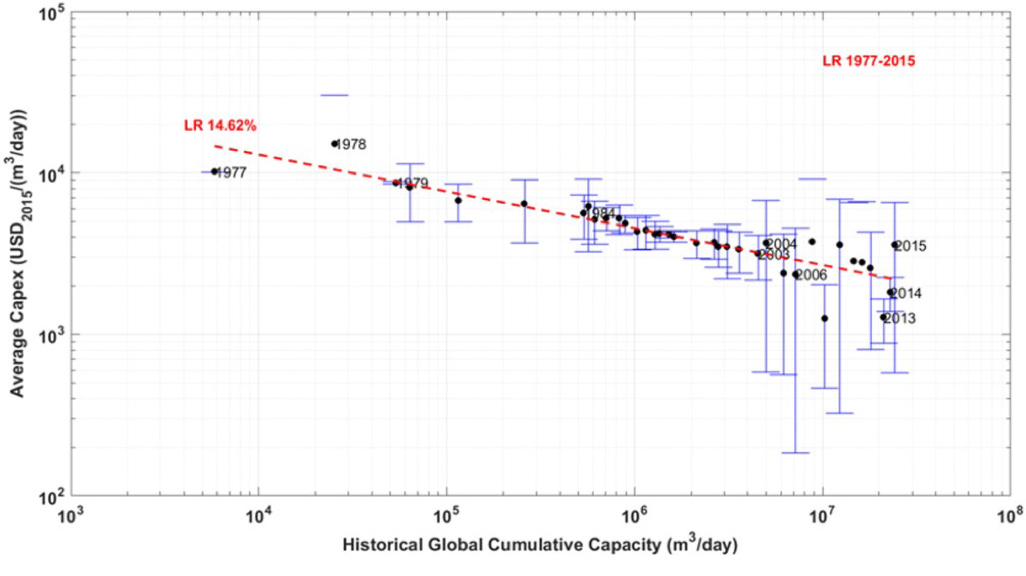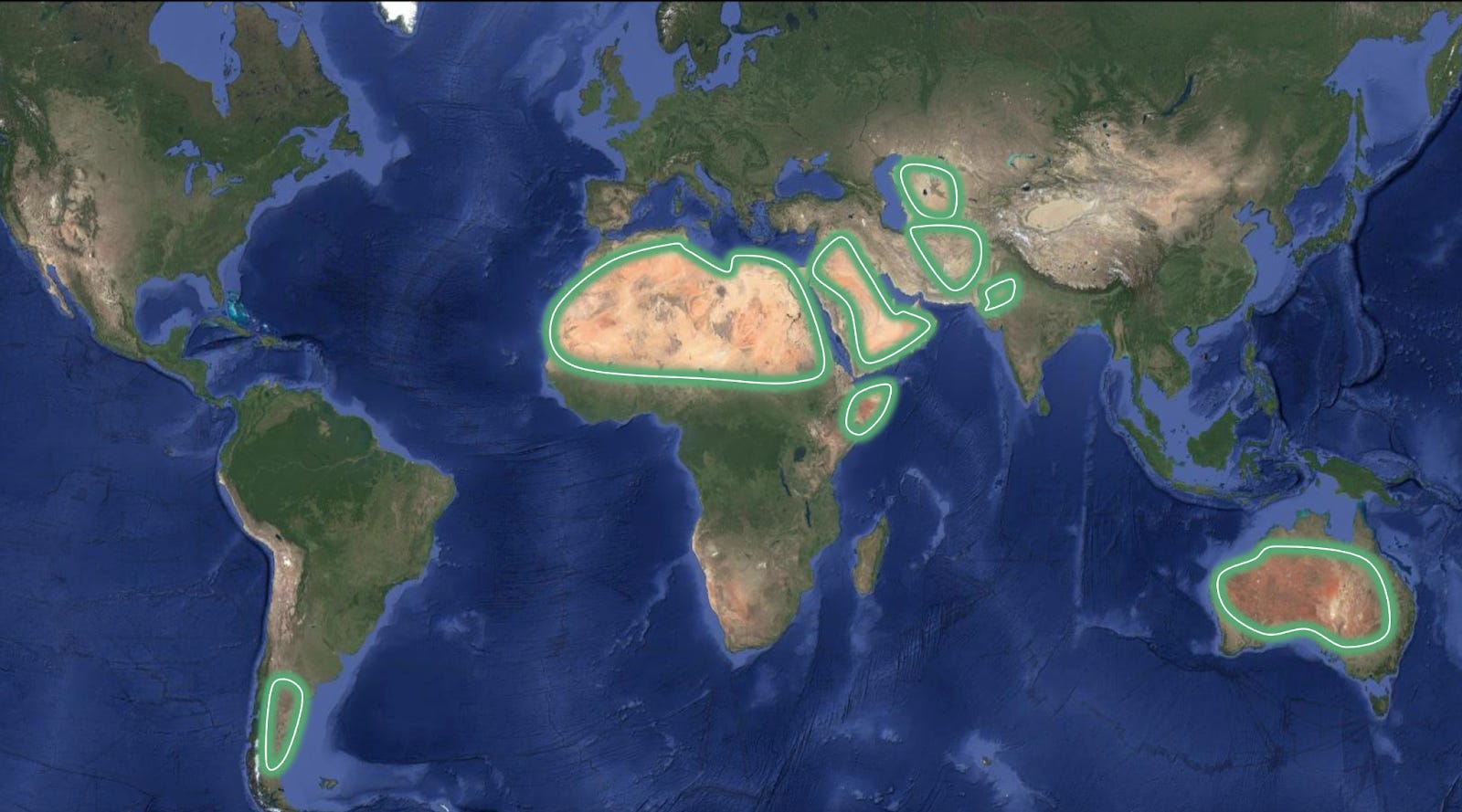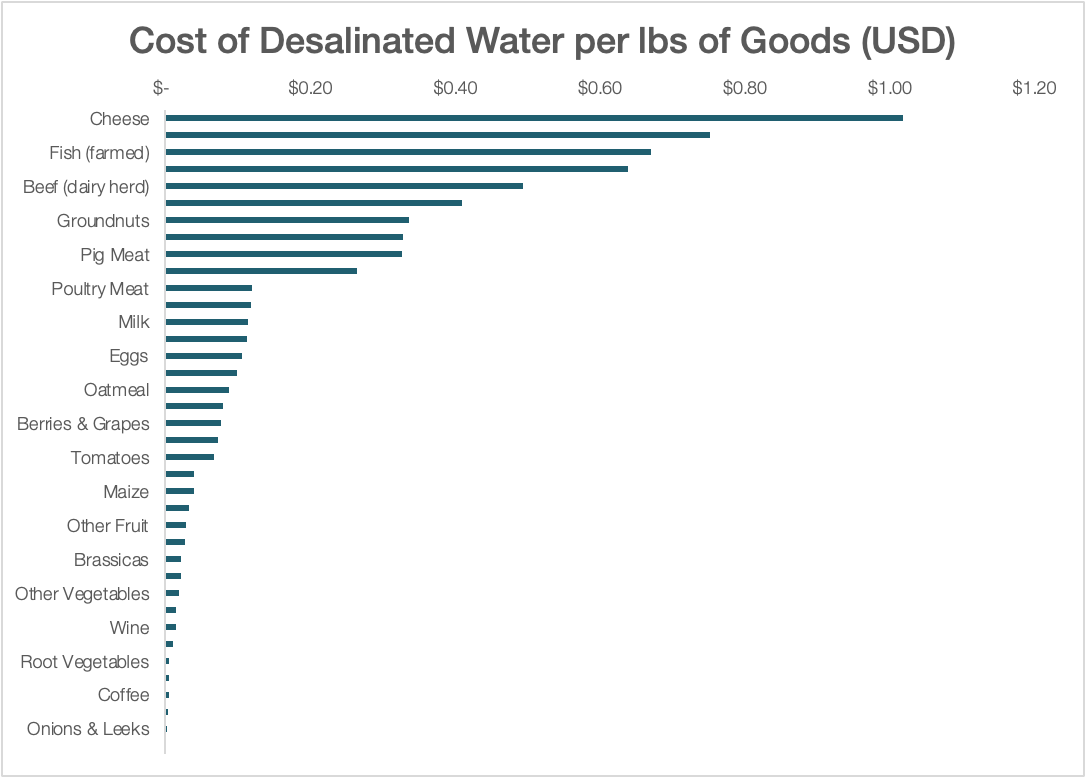Desalination: a Future of Infinite Water
Desalination is finally cheap, and it’s only getting cheaper. Will this usher in a world where humans won’t thirst for water anymore? Where water shortages will be a thing of the past? Where we will be able to live in areas that once were barren deserts?
I only published 2 articles over the last 2 weeks instead of 4. So consider my 2nd week of holidays of the year taken. I will likely take the last 2 in December.
1.1B some have access to freshwater year round. What if we could eliminate their plight forever? That's what we could achieve with cheap water.
But we could do much more than that.
Few people live in the most parched parts of the world.

These areas account for ~14% of all land:
If we could make these areas inhabitable, we could increase our habitable land by about 18%. We could convert places like those on the left into ones like those on the right:
This is already happening. There are about 21,000 desalination plants around the world, supplying water to over 300 million people—about 4% of the world’s population.
Yet the potential is much higher, since nearly 3B people suffer from water scarcity, and if water was more plentiful and cheaper, everybody would consume even more of it.
That’s why the number of desalination plants keeps growing:

The most standard approach to desalination is reverse osmosis: You take some saltwater, push hard on it,1 and pass it through a membrane that retains all the salts and lets freshwater through. It’s like squeezing freshwater out of saltwater.

This is what a membrane looks like close-up:

Reverse osmosis is so much better than every other method of desalination2 that we’re just going to focus on it from now on.
Until very recently, reverse osmosis was extremely expensive, so it was reserved for uses where water is the most valuable, like drinking water in places like Israel, Saudi Arabia, or Dubai. But the cost of reverse osmosis has been shrinking dramatically, and since this trend will continue, it will soon be cheap enough to use in ways we couldn’t imagine before.
The Economics of Desalination
For desalination, we measure water in terms of cubic meters (m3): a cube of one meter per side, which conveniently3 weighs 1 metric ton (T), so I’ll use tons of water from now on—even if in the literature, people tend to use m3.
Today, desalinating water can cost as little as $0.40/ton.4 This number changes based on factors like local energy or construction costs, the source of water, and the size of the plant, but aiming for $0.40/ton for new plants is in the right ballpark.

And what goes into that cost? Approximately this:
Which means that desalinating a ton of water costs approximately:
$0.15 in electricity
$0.18 in construction costs and financing
$0.08 in operating costs and maintenance
Let’s look at the two main costs.
Electricity Costs of Desalination
The electricity cost depends on how much electricity is consumed and the price of that electricity.
Electricity Consumed
The calculation of $0.15 per ton of water is based on the consumption of new, big industrial plants that are best-in-class today, which can use as little as 2 kWh of electricity per ton of water.5 Some research desalination plants achieve 1.8 kWh/ton, but this is getting close to the physical limit of 0.79-1 kWh/ton6, so I don’t think this can shrink much more. Let’s assume we can adopt that 1.8kWh/ton in the industry, for a 10% reduction over current industrial best practices.7
Electricity Price
What about the price? Until now, the cheapest source of energy for desalination tended to be fossil fuels: Countries burned oil and gas to convert seawater into freshwater. Although solar photovoltaics are now the cheapest source of electricity, desalination plants still can’t take advantage of them because they are too expensive to build, and the plants must run 24/7, which requires batteries. When you add batteries to solar costs, they are still not competitive with oil and gas—especially in the oil rich gulf states.
But the prices of both solar photovoltaics and batteries have been dropping at about 12% per year for decades! That’s why solar plus batteries can now cost $0.12 per kWh,8 and that number will keep falling at ~12%/year. Within a decade, even if subsidies disappear, the cost of electricity will go down by 50-65%.
A 10% reduction in electricity consumption and a 50% reduction in electricity prices will mean a total reduction of 55% in electricity costs, from $0.15/ton to $0.07/ton, with fewer constraints to scaling up.9
CAPEX (“Building”) Costs
CAPEX for desalination plants includes things like land, construction, buildings, canals for water to come in and out, pretreatment systems for the water, pumps, energy recovery devices, utilities connections (power, water), engineering, design, permits…
These costs are hard to reduce, but each time a new plant is built, companies find ways to make them cheaper. All in all, they’ve been able to reduce costs by 15% every time the installed capacity doubles.
Capacity has increased by ~6% per year in the last few years.10 If this speed continues, within 10 years we will have installed 75% more desalination capacity. That translates to a reduction of CAPEX costs of ~11%, from ~$0.18 to ~$0.16/ton.
Other operation and maintenance costs are likely to drop a bit, because otherwise they would make a bigger share of costs as CAPEX and electricity costs shrink, and that would put pressure on them to shrink too. Let’s assume they go down by 25%, to $0.06. All in all, it looks like within a decade, the cheapest desalination will go from ~$0.40-0.50 today to ~$0.29-30.
What does that mean? Is this cheap enough for us to drink this water? Manufacture things with this water? Grow produce at these prices? Can we create new cities in the desert with these water costs?
How Expensive Is Desalinated Water?
For Tap Water
This is how $0.30 compares to the price of tap water in different world capitals:

In other words, in the vast majority of the world, desalinating seawater is cheaper than the current price of tap water! And it’s only going to get cheaper!
Here’s one way to make this intuitive: A standard US household uses about 380 tons of water per year. Such a household in San Francisco would pay $2,000 in water per year. The desalination of this amount of water would only cost $114, or less than $10/month. It would consume less electricity than the fridge!
At this cost, virtually all tap water in the developed world could be replaced by desalinated freshwater. This means that we can now build cities in deserts!
Or at least, in deserts close to the sea. Can we do the same inland?
The Cost of Distance for Water
This paper said back in 2005 that lifting one ton of water 100 meters costs approximately the same as 100 km of horizontal transport, or about $0.05/ton. Let’s assume that is still the cost.11
This means that, if we are willing to pay $1 per ton of water, we would need $0.40 for desalination, and would have $0.60 left for transportation. That’s enough to send water inland by 1,200 km or elevating it 1,200 meters—or a combination of the two.
If I’m not wrong, this means that virtually all the land that is green or red here in Australia could be reached at $1/ton or below.

What about the Sahara?
The vast majority of the Sahara could receive desalinated water at $1/ton or less. All but the tallest mountains could receive water at $2/ton or less.

I am doing back-of-the-envelope numbers here. Maybe water transportation in the Sahara is a bit more expensive, or some other assumption doesn’t hold perfectly. The point is not to claim that all the Sahara could receive cheap desalinated water, but rather that technology is already at a point where we could start building cities in the Sahara if we wanted to.
And if it’s true for the Sahara, it’s also true for Arabia, southern Argentina, Somalia, the Thar Desert in India, the flatlands of Pakistan, and some parts of Central Asia—all of which are close to the sea and at low altitude.12
That said, most water is not directly consumed by humans.
Industrial and Agricultural Water
Most water goes either to industry or to agriculture. If these desert places were to be economically viable, they shouldn’t just have drinking water—they should also have water primarily dedicated to these other purposes.
In emerging countries, water is used mostly in agriculture, and in rich countries, it’s a mix of agriculture and industry. So what are water prices like in agriculture and industry around the world?
Industries
This is the wholesale cost of water in different California counties, which is characteristic of what industries pay for water:
The price of desalinated water is in the right ballpark! It looks like:
In Germany, the cost of processing water is similar to that of desalinating it, around $0.50/ton.
In Spain, industrial water costs $2/ton.
In Japan, the production of water costs $1.2/ton.
In Australia, industries pay $0.31/ton.
Frequently, industrial water requires treatment, and that is one of the main drivers of costs. From what I can tell, these costs tend to be similar or higher to those of desalination. Desalination costs would be on top of treatment, so water would be more expensive, but it wouldn’t be tragically more expensive.
What does this all mean?
For countries where water is plentiful and industries where water is a huge fraction of costs, desalination is probably not viable for industry.
But for countries where water is already scarce, or for industries that don’t depend mainly on water, bringing desalinated water is completely plausible!
This gives you a clue on the viability of desalinated water for agriculture.
Agriculture
According to this paper, water prices for agriculture in Europe range from $0.05 to $1.65 per ton. This means that, today, desalinated water would already be a viable alternative in many places!
But outside of Europe, most water for irrigation comes directly from rivers, is not treated, and is very cheap. In California, its price ranges between less than $0.01/ton to $0.40. In the Imperial Valley, one of the biggest sources of produce on Earth, a ton of water costs about 1-2 cents. These prices are common across the US.
According to this paper, agricultural water costs just a few cents per ton in countries like Canada, Morocco, Australia, the UK, Turkey, Spain, or Jordan. Desalinated water would be competitive in others, like Israel, the Netherlands, Tanzania, or Chile.
When water is the main component of a crop’s costs, producing that crop in most countries won’t be viable. But water cost does not factor heavily into every agricultural product!

A cubic meter of water is 1,000 liters. So for example, a kg of cheese needs over 5 cubic meters of water. If it came from desalinated water, that’s $2 per kg right there. Not viable.
But the cost of desalinated water for citrus, wine, or bananas would be just $0.03/kg. So let’s translate this graph into costs of desalinated water per kg of produce:
Here in lbs, for you Americans:
You know what this means?
It means that deserts couldn’t produce every agricultural product in the world. But they could produce a bunch!
And of course, we saw in The Promise of Vertical Farming that using greenhouses can reduce water consumption by up to 95%. This would divide the cost of water per kg of produce by 20x. For something like cheese, water would now cost $0.10 per kg rather than $20/kg, making the use of desalinated water viable. If it’s true for cheese, it would be true for many other products, including most crops.
Takeaways
Desalinated water now costs as little as $0.40 per ton.13
This is likely to drop to $0.30 in the next decade.
This is already cheaper than residential water in most cities in the world.
It’s also in the ballpark of prices of industrial water. We could use desalinated water in industries that are not too thirsty or in countries with water scarcity.
Many agricultural products could be economically viable in new areas if they were irrigated with desalinated water today.
Even products that require a lot of water could be viable, as long as they are produced in greenhouses and their water is not lost to the ground.
In other words: We could reinvent the world with desalinated water.
More precisely, you increase the pressure on the saltwater side to > 27 atmospheres.
This is because most other common desalination mechanisms require evaporating water, which takes a lot of energy, which is expensive. A world with very cheap energy (even just thermal power, like geothermal) might see other desalination mechanisms win over reverse osmosis, but we’re not there yet.
It’s convenient that one m3 of water weighs one ton, but it’s not a coincidence. Originally, the kilogram was defined as the mass of one liter (or one cubic decimeter) of pure water at its maximum density, which occurs at about 4°C. This means that one cubic meter (1,000 liters) of water would weigh approximately 1,000 kilograms, or one metric ton.
In the US, the Department of Energy tells operators they should aim for $0.50/m3. The new plant of Sorek 2 in Israel has a contract to sell water at $0.40/m3. This is the price, not the cost; the cost is likely lower!
1.8 Kilowatt-hours per cubic meter of water. A kWh for industrial use costs about $0.08 in the US, so 1.8 kWh cost ~$0.14, or about the $0.15 mentioned above.
From Energy Issues in Desalination Processes, Raphael Semiat, 2008
20% corresponds to a drop from 2.5 kWh/ton to 2 kWh/ton, or from 2 to 1.6 kWh
I believe this includes subsidies, but since I haven’t looked into batteries in detail yet, I can’t confirm.
And the energy being used will be clean
It looks like 90% of a pipeline’s costs are CAPEX, and that is unlikely to go down. Electricity is a big part of the remainder, but even if its costs shrink by a lot, it won’t make a big dent into overall pumping costs of water. Maybe there are ways to reduce the CAPEX, but these are not obvious to me from the literature, and I haven’t dealt with pipeline pumping personally so I wouldn’t know. I checked how expensive it is to transport oil through pipelines, and it looks like it costs low single digit dollars ($1-$5) per m3 per 100 km, which would make it about 100x more expensive than moving water. Of course, moving oil will be more expensive than water, but that number being so much higher than $0.05 reinforces that costs much lower than $0.05/m3 to move water 100km are unlikely.
The Chilean Altiplano, the Rockies in the US, and the Namib in southern Africa are too elevated for this, while Asian deserts like the Gobi are too far inland.
Casey Handmer had a look at this article (thank you!) and wondered if cloud seeding would be a cheaper way to get freshwater inland. It looks like cloud seeding costs from a few cents per m3 to $0.20/m3, but since it’s less controlled and some of that water would have fallen somewhere else, it doesn’t look like it’s a viable replacement for now.















Vertical farming might be the way to go for things where the water demands are a huge part of the cost *in general*, but I don't think you can vertically farm cheese. Some of those cows are going to be too damn high up.
> I only published 2 articles over the last 2 weeks instead of 4.
I'd prefer if you publish 2 good articles instead of 4 mediocre ones. If you having nothing interesting to write about, it's fine to wait until something fascinating pops up. Being bored is a perfectly valid state - it's much better than being boring.